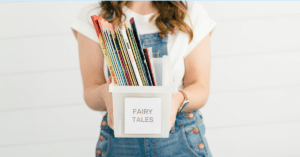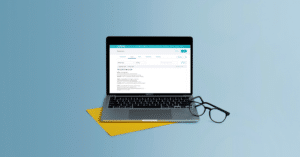Listen on Apple Podcasts Listen on Spotify
This Week’s Episode: How to Get a Language Sample
So far in this month’s podcast series, we’ve reviewed a few of our favorite formal assessments and the importance of narratives in everyday life.
Last week we got a standard score with a normative sample that is appropriate for our students. We dove in and took a closer look at the different language structures with informal assessments.
One of the common things we talked about was collecting a language sample. And that feels super overwhelming when you’ve got a backlog of 5 million evaluations and referrals. I’m exaggerating a bit, but the stress can add up, quick!
So Monica and I thought it would be nice to share some tips on how to collect language samples and hopefully, these quick tips will help minimize your stress levels and how valuable language samples are!
Shall we get to it?
Quick Tips for Language Samples
– Ask yourself, “what do you want from this language sample?”
– Build rapport with the student by asking about their specific interest.
– Are their responses very literal?
– Use a narrative rubric.
– Use a Language Sample Spreadsheet.
Context Samples
– Conversation Sample
– Story Generation
– Story Retell
– Persuasive Sample
– Expository Sample
How to Use the Language Sample Spreadsheet
Click here for your free SLP Now Language Sample Google Spreadsheet
Links Mentioned
– SLP Toolkit Narrative Rubric
– Check out this blog for my 6-step process to quickly and easily collect a language sample.
Subscribe & Review in iTunes
Are you subscribed to the podcast? If you’re not, subscribe today to get the latest episodes sent directly to you! Click here to make your listening experience auto-magic and as easy as possible.
Bonus points if you leave us a review over on iTunes → Those reviews help other SLPs find the podcast, and I love reading your feedback! Just click here to review, select “Ratings and Reviews,” “Write a Review,” and let me know what your favorite part of the podcast is.
Thanks so much!
Transcript
Monica: Hello there and welcome to the SLP Now podcast, where we share practical therapy, tips and ideas for busy speech-language pathologists. Grab your favorite beverage and sit back as we dive into this week's episode.
Marisha: Hello there and welcome to the SLP Now podcast. I am your host Marisha and this month we are diving into all things narratives. So if you head back to episode 90, you can hear a little bit about how Monica and I tackle narrative assessment and just kind of our framework for it. And then the rest of the episodes throughout the month for 91, 92, 93, we'll dive into specific aspects of assessment and just things that we want to consider when we're getting ready to target narratives in therapy.
And without further ado, let's dive right in. So we talked about all of these different informal language activities or assessments that we can use. But one of the common things, because we talked about this throughout when we were talking about the formal assessment, as well as the informal assessment and we talked about collecting a language sample. And that feels super overwhelming when you've got a backlog of 5 million evaluations and referrals and all of the things. And so in my district, we were required to do a language sample so it was frustrating at first. But I'm really grateful that this is how things were set up because I got to learn how incredibly valuable language samples are and I also figured out ways to make them a lot easier. So I thought it'd be interesting though first because we talked about these different tools that we can use in assessment, but Monica, do you collect a language sample?
Monica: Yeah, usually they're pretty basic. I'll just do the minimum that's required by EDCO. To be completely honest, I'm not capturing a 10 minute language sample from these kids. But I think what helps you, right, is to think about in your mind what I want from this language sample before you start it. What do I want to get from this? Is there something that I'm looking for based on what formal and informal assessments that I've given so far that I really kind of want to narrow down, maybe? So that's kind of how I set it up. But do you want to talk about the different contexts that we can sample from language samples?
Marisha: Yeah, of course. And so it's super interesting because I did a lot of conversation samples when I started out and I maybe did some story generation. There's a lot of different types of samples that we can get. So of course, conversation samples. So just having a conversation with the student and then transcribing what they say. Which I guess is optional, there are some nice checklists out there that we can use without having to record the language sample, but we'll get to that later.
So we've got conversation sample, we can have them retell a story, we can have them generate a story. It's super interesting. If you ever have the opportunity to collect multiple samples from the same student, it's really interesting to see how they vary and it can make a huge difference if they're given visuals or not. It's dramatic the difference in language that we can see if they're talking about something that's immediate, something that they can see versus something that they're just asked to retain. Fascinating, fascinating stuff. And I think that could give us a lot of insight if we're comparing, having an immediate reference versus not, that can give us a lot of information.
And if they're really struggling in the classroom with narratives, that can give us a lot of information. So we talked about conversation, story generation, story retell. For older students, I think it's helpful to switch things up too. We can collect a persuasive language sample where they're trying to convince us of something or pretending like they're convincing their parents to let them watch a certain movie or convincing the principal to shorten the school day or to shorten the school week. And that requires some very different language structure than just retelling a story or engaging in conversation. And then expository language samples, they elicit very different types of language as well. So like, how to do something or summarizing a text or whatever it may be.
So those are some things to think about and I've collected lots and lots of different types of language samples just based on the feedback, like the parent and teacher report give us a lot of information, also the assessment results if there's something that I want to look into a little bit more closely, that can be helpful. And then, yeah, just trying to collect the data like Monica said to help kind of answer our questions. So yeah, that's a recap of the context that we'd like to sample. And then Monica, do you want to talk a little bit about how you tackle your language samples and how you make it doable given all of the workload and all of that?
Monica: For sure. I think that kind of talking about that like double duty thing again. I work a lot with the autistic population, so a lot of times if it's their initial or maybe like shy, I can use it as a rapport builder too. So you can ask parents or teachers, what is their special interest? And then you can get them talking about that and they're going to generate a far better language sample than me asking conversational questions.
So then I can kind of see with kind of like memorized things, especially if they're a Gestalt language processor, where is it with that? Again, that's a strength of theirs. That's where we can start off with, I can see where that's at. Because a lot of times for those kids, if they have to do something, they have no picture, no information about it, no prior knowledge, you're not going to get anything. You might get one to two word sentences because they're just trying to give you an answer. But if they talk about their special interests, whoa, that language sample is always amazing. But also I can make note of different things. So, if we're doing a conversational one, are they talking about other people? Are they talking about emotions?
Do they have that language in their vocabulary? So you can connect that back to what teachers or parents might be saying, where they have a really hard time with moments of frustration. And it might be because they don't have that language to express their emotions. So that's something that you can do with the sample. Are they able to work through that? If you ask them about something that they did over the weekend and they talk about a brother or sister and they talked about something that happened that they didn't like, you can get those sort of emotion words, which I think is always super functional. Are they showing perspective taking skills with characters, if you're doing like a wordless picture booking, you're doing a word retell? Are they just doing exactly what's on the page and nothing beyond? Is it very literal?
So those are definitely some of the things that I look for kind of off the top of my head that can be really useful then for thinking about what goals you're going to do and making it something very functional across contexts so then that's generalizing. You're always talking about decontextualized versus contextualized and this is definitely a way to make sure that everything is going to be embedded and to really make sure that you're making a good use of your time.
Marisha: Absolutely. And then in terms of how I tackle a language sample, I like my numbers and my data. And so I get a little bit nerdy with this, but it's totally doable. And it's so impressive to an administrator or even a parent because it's something like when we're describing the things that we're seeing in a narrative, it can feel a little bit fluffy and if we can assign a number to it and then we can see progress over time, I think that's incredibly powerful.
So there's some really great rubrics out there. And I typically use those when I write goals, SLP Toolkit has some amazing narrative rubrics and they also have a language sample checklist too in their tool, I believe. But in terms of getting the numbers, I made a little Google spreadsheet, I'll link to it in the show notes. It has boxes to transcribe the language sample. So as we're having the conversation, as I'm listening to their story, whatever it may be, I try and type it in real time if I can. If I can't, then I'll just record it on my school iPad or whatever, and then just listen back to it later. But then I just type in what the student is saying. And then I use one line per utterance. It has all these smart pieces in it where it automatically counts the words or morphemes if you add spaces between the morpheme.
So just make sure you're being consistent with how you're reporting that. It calculates the total words or morphemes in the language sample. It tells me how many utterances there were. So that gives me the MLU. And then it also has a space to look at the number of clauses that are in there and then whether they're grammatically correct and then there's room to leave notes. So if I'm seeing pronoun errors or if I'm noticing a lack of story grammar structure. Or if I do notice something that they're doing well, I can just jot that down in the notes. And then I just print out that spreadsheet and I can just attach it to the evaluation. We can go over it. Then the parent gets a concrete look at the language sample. Like I said, sometimes I do this with the language sample from the TNL, or I do like the conversation sample or a combination of the above.
It makes it really easy to compare the different samples and it gives us some really good information and it can be helpful for goal setting too. So we probably don't want to do the language sample every week. I've never done that. But it can be helpful to do on a quarterly or semester or maybe even a yearly basis just to see how they're progressing and just having a concrete way to see that progress. And it's really interesting to compare the samples year over year, especially if we use the same type. Like if we use the slam cards in year one and year two, and just being able to see that is really cool. That's how I tackle that. And I'll link to that spreadsheet with a quick little tutorial video if you're interested in trying to use that as well. Monica, anything you'd like to add or any other tips?
Monica: No, I would say same, definitely. I do the same thing and compare the MLU and kind of where their general grammar is at. But I totally agree about having that little record of their language samples. Because for a couple years I would actually have students from preschool up to maybe second grade and so I would end up doing their try and I would remember back, and it was such a great moment in the meeting to be like, this was their language sample from preschool. And this is where they're at now and just have a really concrete record of their progress. And for us to just all celebrate that growth in the meeting was always really fun.
Marisha: Yeah. It's awesome for all the progress monitoring and celebrating and also it gives us really great information. Like with the language sample that I use, if the student is only using simple sentences, maybe we need a goal to write compound or complex sentences. If they are always making verb errors or pronoun errors, we can write a goal to target that. Yeah, it's great all around, especially if we get to attach it to the evaluation for future reference.
Okay. So I think that's a wrap with our language sample tips and tricks. Thanks for listening to the SLP Now podcast. This podcast is part of a course offered for continuing education through speech therapy PD. So yes, you can earn ASHA CEs for listening to this podcast. If you enjoyed this episode, please share with your SLP friends and don't forget to subscribe to the podcast to get the latest episodes sent directly to you. See you next time.
Sign up to receive email updates
Enter your name and email address below and I'll send you periodic updates about the podcast.




Reader Interactions